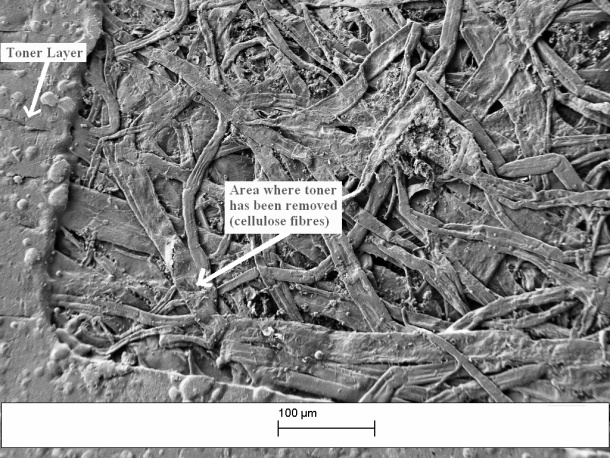UK researchers develop 'un-printing' laser tech

University of Cambridge researchers have developed a way to strip ink from paper that leaves the paper ready to be re-used, raising the possibility of 'un-printers' being developed.

Researchers have developed a method for removing ink with a laser. The image above taken with a Scanning Electron Microscope shows an area of paper where toner has been removed through laser ablation. Image credit: University of Cambridge
The technique, announced on Wednesday, involves short bursts of green laser light that are sufficient to vaporise printed toner, but not so harsh as to destroy the paper. Cambridge's Low Carbon Materials Processing Group leader Julian Allwood and PhD student David Leal-Ayala published their findings in the Proceedings of the Royal Society A journal.
According to Allwood and Leal-Ayala, paper can be reused around three times via this method before it is thinned out or yellowed to the point where recycling is the sensible option.
"Material recovery through re-using eliminates the forestry step from the life-cycle of paper and eradicates emissions arising from paper incineration or decomposition in landfill," Allwood said in a statement. "This could represent a significant contribution towards the cause of reducing climate change emissions from paper manufacturing."
The Cambridge team worked alongside the Bavarian Laser Centre to test 10 different laser arrangements by varying wavelengths, strengths and pulse durations on standard Canon copy paper and HP LaserJet black toner.
Toshiba already sells equipment to remove printer ink with heat, but that approach relies on the use of a special blue ink sold only by Toshiba.
Now that the right kind of laser has been found — with a green wavelength of 532nm and a four-nanosecond pulse length — the next step is to build a prototype 'un-printer' and commercialise the technology.
"What we need to do now is find someone to build a prototype," Allwood said. "Thanks to low-energy laser scanners and laser-jet printers, the feasibility for re-using paper in the office is there."
Get the latest technology news and analysis, blogs and reviews delivered directly to your inbox with ZDNet UK's newsletters.